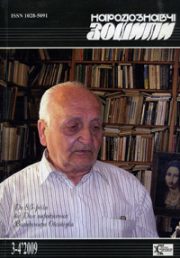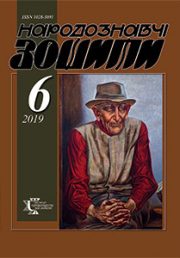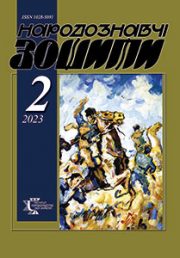The Ethnology Notebooks. 2022. № 3 (165), 685—690
UDK 398.47:[392.51:636.5](477)
DOI https://doi.org/10.15407/nz2022.03.685
SEREBRYAKOVA Olena
- ORCID ID: https://orcid.org/0000-0002-1039-2920
- candidate of Historical Sciences (= Ph. D. in history),
- researcher of the department of Modern Ethnology
- of the Ethnology Institute
- of the National Academy of Sciences of Ukraine,
- 15, Svobody Avenue, 79000, Lviv, Ukraine,
- Contacts: e-mail: o-sereb@ukr.net
Abstract. Folk divination is an important component of the ancient and traditional culture of Ukrainians in particular of calendar ritualism.
The aim of the offered article is coverage of the layer of customs and rituals, worldview phenomena associated with the divination about the marriage with the help of domestic birds.
The object of the research is the traditional worldview, the customs and rite culture of the inhabitants of Ukraine, and the subject — the marriage mantic ritual actions by the behavior of domestic birds, which carried out during winter calendar holidays. The basis of the article are the materials of the field research, local folklore articles and works of the nineteenth and the beginning of the twenty-first centuries.
The methodology of this work is based on general scientific methodological principles and the basic requirements that apply to the works of historical and ethnological direction. The author uses a various methods (field observation, comparative-historical, comparative, reconstructive, structural-semantic and method of cross-cultural comparisons).
Attention is drawn to the prophetic abilities of the rooster and the chicken, which have been known since ancient times. Mantic actions (for example, with different symbolic attributes etc.), local beliefs and signs related to predicting marital destiny based on observation of the behavior of domestic birds during the winter calendar holidays of residents of different regions of Ukraine are analyzed. By interpreting certain signs, unmarried people tried to predict who will be the first to get married, who will «manage» the family, what will be the character of the marriage partner, how family life will turn out etc. Mostly such mantic actions were performed by girls, less often by boys or collectively. Similar calendar matrimonial divinations and beliefs existed in other Slavic peoples.
Keywords: mantic actions/practices (divination), Ukrainians, cock, hen, grain, water, coins, mirror, bread, coal, marriage.
Received 30.05.2022
REFERENCES
- Serebriakova, O. (2015).Maidens’ divination based on the voices of domestic animals (Carpathian studies). Lemkos, Boykos, Ruthenians — history, modern times, material and spiritual culture. Slupsk; Zielona Gora; Svidnik(Vol. 5, pp. 727—740) [in Ukrainian].
- Serebriakova, O. (2015). Winter divination of dog behavior in Cherkasy region. Naukovi zapysky (Issue 13—14, pp. 150—157). Ivano-Frankivsk [in Ukrainian].
- Serebriakova, O. (2016).Local features of divination with the participation of a dog and a cat in the Pokuttya region. The Ethnology notebooks, 2 (128), 398—404 [in Ukrainian].
- Tolstoj, N.I. (2004, 2009). Slavic Antiquities: Ethnolinguistic Dictionary: in 5 vol. (Vol. 3, 4). Moskva: Mezhdunarodnye otnoshenija [in Russian].
- Archive of the IN NANU. F. 1. Op. 2. Od. save 588. Arc. 1—121 [in Ukrainian].
- Archive of the IN NANU. F. 1. Op. 2. Od. save 701. Arc. 1—104 [in Ukrainian].
- Skrypnyk, H. (Ed.). Ethnographic image of modern Ukraine. Corps of expeditionary folklore and ethnographic materials. Calendar rituals (Vol. 6). NAN Ukrainy; IMFE named after M.T. Rylsky. Kyiv [in Ukrainian].
- Vadym, K. (1938). Divination of birds. Zhyttia i Znannia (Part 7—8, pp. 219—220). Lviv [in Ukrainian].
- Zelenin, D.K. (1991). East Slavic ethnography. Moskva: Nauka; Glavnaya redaktsiya vostochnoy literatury [in Russian].
- NANF IMFE NAN of Ukraine. F. 14—5. Act. 653. Arc. 1—10 [in Ukrainian].
- Tysovych, M. (1938, 7 January). Customs and beliefs at St. Andrew. Meta (Part 1 (348), p. 11). Lviv [in Ukrainian].
- Archive of the IN NANU. F. 1. Op. 2. Od. save 608. Arc. 1—354 [in Ukrainian].
- Petrova, N. (2011). Calendar ritualism of Ukrainians of Mykolayiv district of Odesa region in the middle of the XX th century: new field materials. Calendar ritualism in the life of the ethnos: collection of scientific works: materials of the International Scientific Conference «Odessa Ethnographic Readings» (Pp. 267—278). Odesa [in Ukrainian].
- Medvedyk, P. (1996). The village of Zhabynia in the Zboriv region. Weddings, folk customs and ceremonies. Ternopil [in Ukrainian].
- Chubinsky, P.P. (1872). Folk diary. Proceedings of the ethnographic-statistical expedition to the Western Russian region, equipped by the Imperial Russian Geographical Society: materials and research collected by P.P. Chubinsky (Vol. 3). Sankt-Peterburg [in Russian].
- Pelenychka, O. (1935). St. Andrew’s evening (Folk rites and customs). Zhinka (Part 24, p. 7). Lviv [in Ukrainian].
- Voropaj, O. (1958). Customs of our people. Ethnographic essay: in 2 vol. (Vol. 1). Munich: Ukr. edition [in Ukrainian].
- Kurochkin, O.V. (1978). New Year’s holidays of Ukrainians: traditions and modernity. Kyiv: Naukova dumka [in Ukrainian].
- Archive of the IN NANU. F. 1. Op. 2. Od. save 533. Arc. 1—183 [in Ukrainian].
- Archive of the IN NANU. F. 1. Op. 2. Od. save 659. Arc. 1—186 [in Ukrainian].
- Archive of the IN NANU. F. 1. Op. 2. Od. save 704. Arc. 1—489 [in Ukrainian].
- Archive of the IN NANU. F. 1. Op. 2. Od. save 787. Arc. 1—200 [in Ukrainian].
- Koperzhynsky, K. (1929). Calendar of folk rites of the New Year cycle. Original citizenship and its remnants in Ukraine (Issue 3, pp. 14—97). Kyiv [in Ukrainian].
- Mysiuk, I.Yu. (2000). Mountain rainbow. Sniatyn: PrutPrynt [in Ukrainian].
- Markevich, N.A. (Ed.). (1991). Customs, beliefs, cuisine and drinks of Ruthenians. Kyiv: Dobrovol’noye obshchestvo lyubiteley knigi URSR [in Russian].
- Dykarev, M. (1905). People’s calendar of Valuysky district (Borysiv volost) in Voronezh region. Materialy do ukrains’ko-rus’koi etnol’ogii (Vol. VI, pp. 113—204). Lviv [in Ukrainian].
- Domanytskyy, V. (1912). People’s calendаr in the Rivne County, Volyn Guberniya. Materialy do ukrains’koi etnol’ogii (Vol. XV, pp. 62—89).Lviv [in Ukrainian].
- Mojsej, A.A. (2008). Magic and mantic in the folk calendar of the East-Romanian population of Bukovina. Chernivtsi [in Ukrainian].
- Kopernicki, I. (1887). The sketch to the ethnography of the Ruthenians in Volyn from the materials collected by mrs. Zofija Rokossowska in the village Yurkivshchyzna. Zbior wiadomosci do antropologii krajowej (Vol. 11, pp. 130—228) [in Polish].
- Khomyk, V. (1963). Lemko’s customs and rites. Nashe slovo, 23, 5. Warshava [in Ukrainian].
- Bogdanovich, A.V. (1877). Collection of information about the Poltava province. Poltava: Tipografнya Gubernskago Pravleniya [in Russian].
- Makovij, H.P. (1993). Trampled flower: ethnographic stories. Kyiv: Ukr. author [in Ukrainian].
- Ivanov, P. (1907). Life and beliefs of the peasants of the Kupyansk district, Kharkov province. Kharkov: Pechatnoye Delo [in Russian].
- Ben’kovskiy, I. (1895, December). Maiden Feast of St. Andrew. Kiyevskaya starina. Kyiv: Tipografнya G.T. Korchak-Novitskago (Vol. 51, book 12, pp. 100—103) [in Russian].
- NANF IMFE NAN of Ukraine. F. 14—3. Act. 6. Arc. 1—128 [in Ukrainian].
- Afanas’yev, A.N. Poetic views of the Slavs on nature. Experience in the comparative study of Slavic legends and beliefs in connection with the mythical tales of other hundred peoples: in 3 vol. (Vol. 1). [B. m.]: [b. i.], [b. g.] [in Russian].
- Nikiforovskiy, N.Ya. (1897). Folk signs and beliefs, superstitious rites and customs, legendary tales of persons and places. Collected in Vitebsk Belarus N.Ya. Nikiforovskiy. Vitebsk: Gubernskaya Tipo-Litografнya [in Russian].
- Zabylin, M. (1992). Russian people, their customs, rituals, legends, superstitions and poetry. Moskva: Avtor [in Russian].
- Dmitrieva, S.I. (1988). Folklore and folk art of Ruthenians of the European North. Moskva: Nauka [in Russian].
- Golebiowsky, L. (1830). Polish people. Their traditions, superstitions. Warszawa [in Polish].
- Federowski, M. (1897). Belorussian people in Lithuanian Ruthenia. Materials for Slavic ethnography collected in the years 1877—1891 (Vol. 1). Krakow [in Polish].







